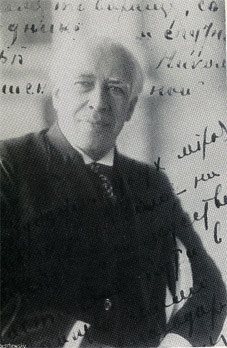 Konstantin
Stanislavsky (1863-1938) was the son of a wealthy Russian
merchant. Bitten by the theatrical bug early in life,
he became an actor and director. In 1898, together with
Vladimir Nemirovich-Danchenko, he created the Moscow Art
Theater (MAT). The theater, with its emphasis on realistic
presentation and its careful attention to every detail
of the production, was successful from the time of its
debut (Alexei Tolstoy’s Tsar Feodor Ioannovich).
The debut season also featured Anton Chekhov’s The
Seagull. In the years that followed, the MAT under
Stanislavky’s often autocratic direction, created
a series of legendary productions during the first decade
of its existence including Chekhov’s Uncle Vanya,
The Three Sisters, and The Cherry Orchard,
Maxim Gorky’s Lower Depths, Leonid Andreev’s
Life of a Man. After the Russian Revolution, Stanislavsky
remained in the Soviet Union and continued to run the
Art Theater. Between 1922 and 1924 the troupe engaged
in a triumphant series of guest performances in Europe
and the United States. After his return from this tour,
Stanislavsky added a number of major Soviet plays to the
Art Theater.’s repertoire, including Mikhail Bulgakov’s
Days of the
Turbins, Valentin Kataev’s Squaring the
Circle, and Vladimir Kirshon’s Bread.
Konstantin
Stanislavsky (1863-1938) was the son of a wealthy Russian
merchant. Bitten by the theatrical bug early in life,
he became an actor and director. In 1898, together with
Vladimir Nemirovich-Danchenko, he created the Moscow Art
Theater (MAT). The theater, with its emphasis on realistic
presentation and its careful attention to every detail
of the production, was successful from the time of its
debut (Alexei Tolstoy’s Tsar Feodor Ioannovich).
The debut season also featured Anton Chekhov’s The
Seagull. In the years that followed, the MAT under
Stanislavky’s often autocratic direction, created
a series of legendary productions during the first decade
of its existence including Chekhov’s Uncle Vanya,
The Three Sisters, and The Cherry Orchard,
Maxim Gorky’s Lower Depths, Leonid Andreev’s
Life of a Man. After the Russian Revolution, Stanislavsky
remained in the Soviet Union and continued to run the
Art Theater. Between 1922 and 1924 the troupe engaged
in a triumphant series of guest performances in Europe
and the United States. After his return from this tour,
Stanislavsky added a number of major Soviet plays to the
Art Theater.’s repertoire, including Mikhail Bulgakov’s
Days of the
Turbins, Valentin Kataev’s Squaring the
Circle, and Vladimir Kirshon’s Bread.
In addition to his
work as actor, director, and entrepreneur, Stanislavsky
was also an inspiring teacher,whose Soviet disciples included
Vsevolod Meyerhold and Evgeny
Vakhtangov. The influence of his "Method" was
and remains extensive in the United States as well, especially
through the influence of Lee Strasberg.